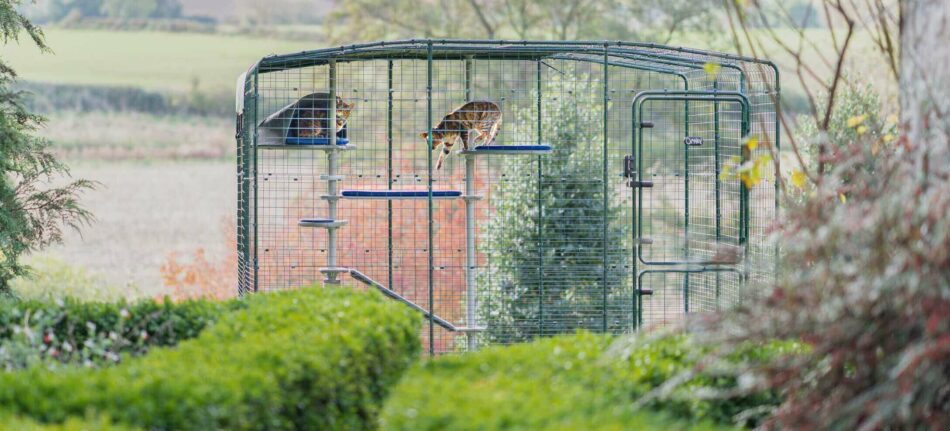What to consider before rescuing a cat
So you’re thinking about adding a cat or kitten to your family? Congratulations! But before you leap into feline parenthood, there are several crucial factors to consider to ensure you and your future furball enjoy a harmonious life together. The most important factor being where are you going to get your new furry friend. Rescuing a cat isn’t just an act of kindness, it’s a commitment that can span a decade or more. Luckily for you, we’ve compiled everything you need to know and consider before rescuing a cat.
Should I buy or rescue a cat?
Before going ahead with buying a kitten from a breeder, it’s important to remember there are lots of cats in rescue centres across the country, waiting for their forever homes. At Omlet, we strongly encourage visiting your local cat rescue before making a decision as there are a number of cats of all ages and breeds in centres. Here are some things to consider when deciding whether you should buy or rescue a cat:
Buying a cat:
- Breed preference: When you get your new furry friend from a breeder, you do have the ability to choose what specific cat breed you want. If, for example, you’re an allergy sufferer and need a hairless or hypoallergenic cat, then choosing this route might be best.
- Kittens available: While many rescue centres have kittens for adoption, the timing on when you want one and when they are available may not always match up. So if a kitten is a must for you, buying from a breeder may be best.
- Predictable temperament: No one can ever know for certain the true temperament of any animal, but when you buy a kitten or cat from a breeder you do get more information on their behaviour type as they know the parents and how they act.
Rescuing a cat:
- Saving a life: Adopting a cat or kitten from a shelter or rescue organization gives a homeless cat a chance at a loving home, potentially saving their life. But ask any parent of a rescue cat and they will say it was their furry friend that gave them the new appreciation for life.
- Diverse options: When you visit a rescue or shelter, one of the first things you’ll notice is the wide range of cat breeds, ages, and personalities that are available to be a part of your family. This variety allows cat lovers to truly discover which cat best suits their preferences.
- Lower cost: In general, adoption fees to get a rescue cat are lower than if you were to buy from a breeder. And, most rescue organizations provide essential vaccinations and spaying/neutering services, which saves even more in additional costs to consider.
Is my home, garden, and neighbourhood safe for a cat?
Think about where your home is located. Do you live by a busy street? This is important to consider as some rescue cat centres will actually not allow adoption if you live near a busy road – and for good reason. Some cats are skittish and can often put themselves in danger or at risk of injury when near a busy street. So to help avoid any unwanted tragedies, shelters and rescues avoid adopting out to these locations altogether.
Next, you need to consider whether your current home is really suitable and safe for a cat to be going outdoors. Is your garden space big enough, fenced in, and far enough away from neighbouring pets? If you didn’t answer ‘yes’ to all of these – fear not. You can still provide an alternative, secure outdoor space for your cat to play and exercise, such as an Outdoor Cat Run.
And if you live in an apartment and want to rescue a cat to be both an indoor and outdoor cat, you, too, can make it happen. With the Omlet Cat Balcony Enclosure you will give your cat the freedom to get some fresh air and playtime outside without fear of escape or injury.
Finally, it’s time to assess the surroundings within your home. Do you have other animals who could respond negatively to a new furry resident? When considering adopting a cat from a rescue or shelter, it’s important to first conduct a “meet and greet” with the other pets and children in your household. This allows everyone to get a firsthand experience of each other and see if there are any personality differences before welcoming a new member into the family.
Can I offer a secure space for the cat to feel comfortable?
For rescue cats, having their own space to hide when they get scared or anxious is incredibly important. Does your home have plenty of hiding spaces for your new cat to disappear to when it all gets too much?
The Maya Nook Indoor Cat House is the ideal den for nervous cats to be tucked away in or just to find their personal peace and quiet. The exclusively designed curtains provide a completely secluded space which allows your cat the ability to feel safe while still being able to check on their surroundings.
Can I provide a rescue cat with the support they need?
One of the best parts of rescuing a cat is seeing the transformation in their personality as they realize they are now part of a loving home. But in order for your new, rescued friend to feel at ease, they’ll need to receive lots of patience and support from you. Becoming settled into a new environment and new life takes time and will require you to be flexible and understand that it doesn’t happen overnight.
Consider first your job – do you want to rescue a cat but work full-time? If so, try and plan some days off before you bring your rescue home to allow much needed time to help your new furry friend get settled in. Spend this time helping them get used to their new surroundings and know where their litter box and cat food bowls are. And if your household has children, you’ll need to prepare them as well to be gentle and quiet with the new cat.
Most rescue cats are discharged from rescue homes with a full bill of health, but on the odd occasion they’re not, some cats may need a few more vet visits, or even repeat medication. If you rescue such a cat, be prepared to accept the cost and commitment required to provide the healthcare they need.
What will I need to settle a rescue cat into my home as smoothly as possible?
While love and patience are the two most important ingredients in making your new rescue adjust to life in your home, there are some essential cat products that will help make this transition easier on everyone.
- Bathroom time: Litter tray, cat litter, scoop
- Sleep time: Cat bed(s)
- Eating time: Cat food bowls – speak to the rescue centre about what food the cat has responded to best, e.g. wet or dry
- Reward time: Cat treats
- Playtime: Cat toys
- Travel time: Cat carrier
- Zen time: Calming products – e.g. Feliway
- Safe outdoor time: Outdoor cat enclosure
Omlet and your rescue cat
At Omlet, we are a pioneering company in cat care. We craft our products to simplify cat rescue efforts and make pet parenting easier. By understanding feline behaviour and the challenges and rewards associated with rescuing a cat, we are able to design innovative solutions that make the process effortless. From our supportive and comfy cat beds to our furniture-style cat houses to our safe and secure outdoor Catio enclosure, we think about your cat first so all you need to do is be the best rescue cat parent you can be.
This entry was posted in Cats

